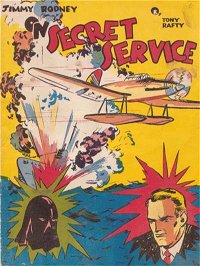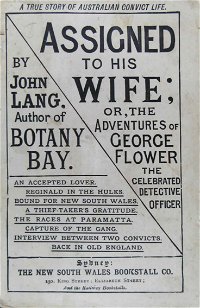NSW Bookstall by James Zee
Establishing the bookstall network
For a few years from 1940, the long-running NSW Bookstall Company engaged local artists to establish the first distinctive line of Australian comics, including some creators who would continue to produce comics and cartoons for many decades—especially Noel Cook and Brodie Mack.
It was probably in 187911Some sources suggest Lloyd arrived in Sydney in 1881 and founded NSW Bookstall at that time. However, 1879 is also... that Henry Lloyd (1847-1897) gained the rights to run bookstalls at train and ferry stations in NSW, established the N.S.W. Railway Bookstall Company, and modernised an operation previously focused on ticket sales.
Lloyd had arrived from the United Kingdom that year after working with the famous English bookstall firm W.H. Smith and Sons.22'Personal' (2 October 1897). Freeman's Journal (Sydney, NSW: 1850-1932), p. 20. Retrieved 16 September 2017, from nla.gov.au/nla.news-article115472208.... Securing the opportunity for a similar business in Sydney, he brought that British approach to an expanding chain of Sydney bookstalls, initially in Redfern, Newcastle, Parramatta and Granville.
On 12 November 1881, Lloyd announced 'Progress at Newcastle' in regional NSW, with 'a handsome and well stocked bookstall' and 'newspapers at published prices' and books and stationery 'at less than Sydney prices, marked in plain figures'.33'Advertising' (12 November 1881). Evening News (Sydney, NSW: 1869-1931), p. 5. Retrieved 16 September 2017, from http://nla.gov.au/nla.news-article107225634....
Then in November, he announced similar progress for 'The bookstall at Sydney Terminus', Redfern from 1 January 1882: 'a large and varied assortment of books, in all classes of literature, stationery and newspapers of every kind''.44Advertising (16 December 1881). The Sydney Morning Herald (NSW: 1842-1954), p. 8. Retrieved 16 September 2017, from nla.gov.au/nla.news-article13501335.... A contemporary reporter enthused:
"The Railway Bookstall Company have taken the initiative in the establishment of bookstalls at the principal railway stations throughout the colony. A very handsome stall, similar to those with which travellers on the English railways are familiar, has been fitted up at Redfern station, and the system has already been extended to several other stations. The plan adopted by the company for the display and disposal of books, periodicals, newspapers, &c., is an adaptation of that which, during the past 40 years, has become such a marked success throughout England under the management of Messrs. W. H. Smith and Sons. At present the company's stalls are for the sale only of books, &c., but we believe it will prove a convenience to the public to have a lending library established in connection with the stalls, as in Victoria, so that railway travellers would be able, for a small fee, to borrow a book at one station, and return it at another."55'The Week' (21 January 1882). The Sydney Mail and New South Wales Advertiser (NSW: 1871-1912), p. 114. Retrieved 16 September...
By 1883, the company had bookstalls spread to stations at Redfern, Newtown, Petersham, Ashfield, Burwood, Granville, Parramatta, Goulburn, Albury, Narandera, Junee and Newcastle, as well as stores at the corner of Elizabeth and Liverpool Streets, and 130 King Street in the city.66For information on locations, see 'Advertising' (17 August 1882). Evening News (Sydney, NSW: 1869-1931), p. 1. Retrieved 16 September 2017,...
At some point around 1883/84, Lloyd completely abandoned the trading name N.S.W. Railway Bookstall Company in favour of N.S.W. Bookstall Company.77It is unknown when 'Railway' was formally dropped from the name. In 1911, the N.S.W. Bookstall Company became a private... He published some paperback fiction books, generally reprints or editions of books printed and published in England, with the NSW Bookstall imprint added for Australian distribution.88For example 'new editions' of John Lang's Botany Bay or, True tales of Early Australia and Assigned to his Wife...
Lloyd died suddenly of a heart attack on Friday 24 September 1897.99'By Telegram' (25 September 1897). Wagga Wagga Express (NSW: 1879-1917), p. 2. Retrieved 16 September 2017, from nla.gov.au/nla.news-article145694000; and... His widow briefly retained ownership of the company under the management of Alfred Cecil Rowlandson.1010Untitled (2 October 1897). The Australian Star (Sydney, NSW: 1887-1909), p. 5. Retrieved 16 September 2017, from nla.gov.au/nla.news-article231804139. 'Fast... She initially offered to sell the company to her son-in-law, Reginald Watkin Smyth Wynn (1866–1925), who declined (but later became Managing Director). Rowlandson subsequently bought the firm.
Australian-born AC Rowlandson (15/6/1865–15/6/1922) had limited formal education and entered the workforce aged eleven as shop boy at a Shilling Shop.1111General information about Rowlandson is from: — Wynn, R, A.C. Rowlandson: Pioneer Publisher of Australian Novels (Sydney: Bookstall?,... At 19 years of age he joined the NSW Bookstall Company selling tram tickets and was a manager by 1887. Within a year of Lloyd's death, he acquired the company as sole proprietor and successfully retained the government rights to operate railway bookstalls in Sydney.1212Untitled (18 November 1897). The Sydney Morning Herald (NSW: 1842-1954), p. 4. Retrieved 16 September 2017, from nla.gov.au/nla.news-article108759837....
References
— Wynn, R, A.C. Rowlandson: Pioneer Publisher of Australian Novels (Sydney: Bookstall?, 1922). A digital copy is available at the State Library of Victoria.
— 'A.C. Rowlandson: Founder of a Great Australian Publishing Business' (1918, 1 October), in The Lone Hand New Series v8#11, p. 456-457. A digital copy is available at the National Library of Australia.
—Mills, Carol, 'An Australian "Dime Novel" Publisher' in Bulletin of the Bibliographical Society of Australia and New Zealand 16 (1992) #1, p.29-37.
—Mills, Carol, 'The Bookstall Novel: An Australian paperback revolution 1904-1946' in Australian Cultural History #11 (1992), p. 87-99.
—Mills, Carol, The New South Wales Bookstall Company as a Publisher Canberra : Mulini Press, Bibliographica historica Australiae #1.



